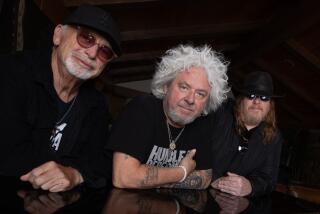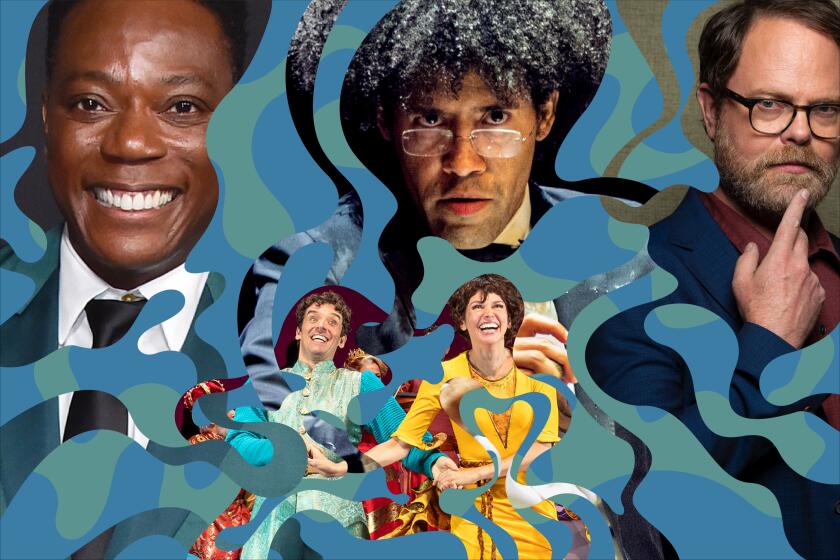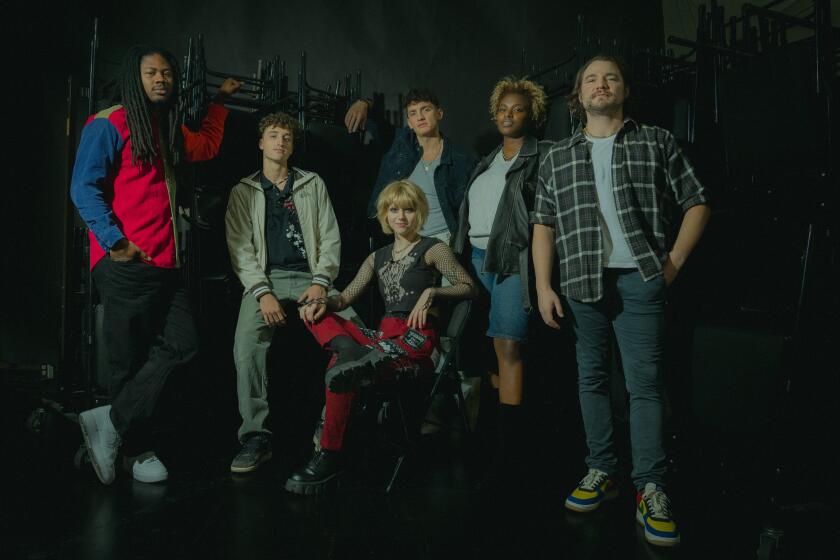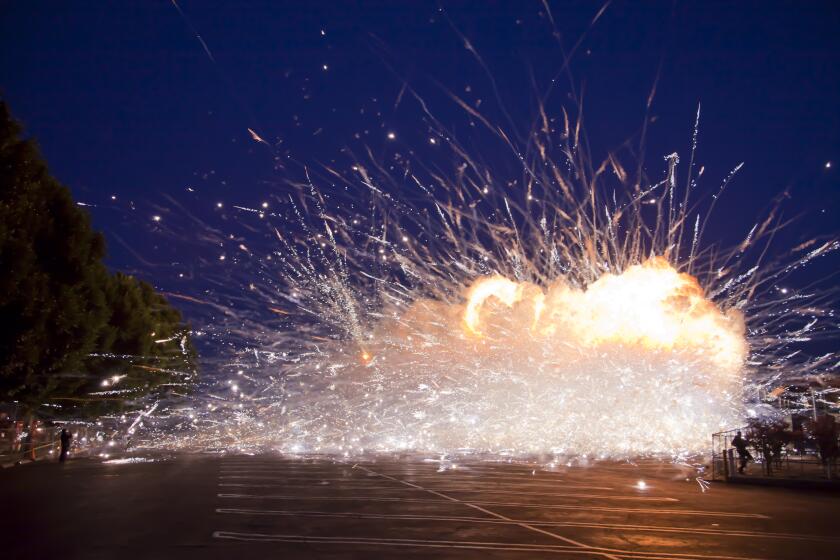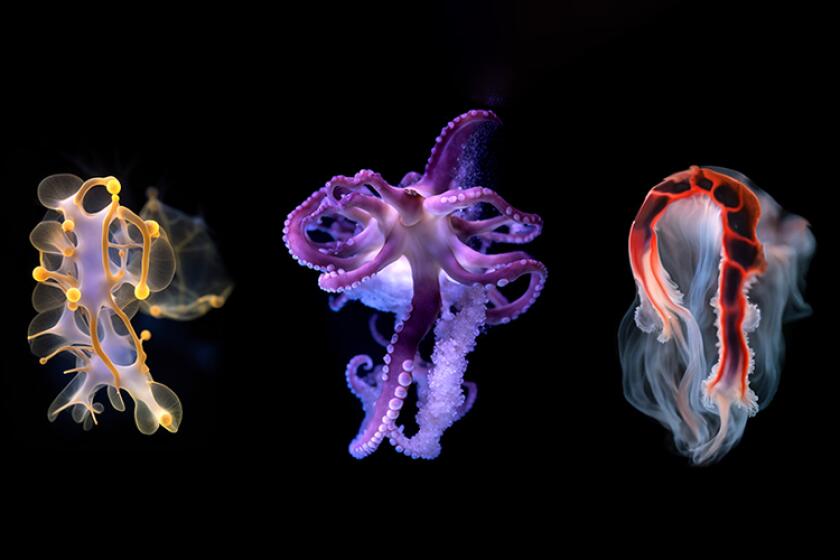SIGHTS AROUND TOWN : Golden Art : The Santa Barbara Museum of Art marks its 50th anniversary with a collection of nostalgic and patriotic paintings.
The Santa Barbara Museum of Art celebrated its 50th anniversary last weekend with generous doses of pomp, circumstance and child’s play. What sometimes seemed like a goo-goo Dada work of public-performance art was also a rightfully proud celebration of half a century in active cultural duty. During that time, the Santa Barbara Museum of Art has become one of the finest mid-sized art museums in the country.
On Saturday morning, scores of kids were dragged away from their TV sets and paraded downtown to the closed-off block of State Street in front of the museum to get some culture. Well, truth be told, the main lure was not the newly opened exhibitions--of older American art, precious Asiana, and newer Santa Barbaran art--but a personal appearance by that cultural icon of the pint-sized set, the Cookie Monster.
Flag-waving, for some reason, was the order of the day. The museum’s Greco-Roman facade was festooned with giant red, white and blue balloons. The similarly colored Dos Pueblos band and drill team went through their paces to the tune of several patriotic tunes: “Battle Hymn of the Republic,” “Yankee Doodle,” “Dixie.”
After the usual complement of proclamations, back-patting and niceties from museum officials and local politicos (by proxy, anyway), the furry blue guest of honor finally appeared and kicked off a chaotic, polytonal and polyrhythmic version of “Happy Birthday” that would have done Charles Ives proud.
Concerned culturati in the crowd might well have asked: What price art museums? What’s Sesame Street got to do with it? For that matter, what’s patriotic hoopla got to do with it?
Such cynicism aside, the museum’s focus in the last few years has rightly been on democratization--trying to shake its elitist image. As incoming director Paul Perrot pointed out at the commemoration: “The place belongs to everyone in the community.”
The public relations campaign has reached down especially to the younger set of artists and art appreciators. In July, the new Ridly-Tree Educational Center--in the renovated McCormick House a few blocks away--will open, increasing the museum’s educational program by tenfold.
Present Director Richard West--who will pass the baton to Perrot in September--assembled the “America in Art: Fifty Great Paintings Celebrating Fifty Years” by borrowing works from museums around the country. West reasons that the show makes a logical historical link with the inaugural show at the museum in 1941, which Director Donald Bear called “Painting Today and Yesterday in the United States.”
Ironically, though, the current show could be subtitled “Painting of Yesteryear in the United States.” Modernism doesn’t even make a token appearance.
For the museum’s 25th anniversary in 1966, then-Director Thomas Leavitt organized a much more cutting-edge show, “Directions in Kinetic Sculpture.” The current feast of American art--mostly from the 19th Century--could reflect the conservative mood of our era. Maybe the art world was, in spirit, younger in 1966. Or maybe, given that the museum was then smaller and less burdened by overhead, it could afford to take more chances.
The new American show also complements one of the museum’s strong suits: its permanently installed Preston Morton Collection of American Art. This was the collection that affluent patron Preston Morton built, with the aid of then-Director James Foster Jr., in the late ‘50s. The steady increase of American art, in both critical regard and market value, would make the creation of such an instant collection virtually impossible today.
“Fifty Great Paintings” is a fascinating show in many respects, not only for its bursts of aesthetic pleasure (no, they aren’t all great paintings) but on more nostalgic and, yes, even patriotic levels.
Frederic Edwin Church’s “Our Banner in the Sky,” which graces the exhibition catalogue cover, blends celestial meditation with ethnocentricity. Church, like many proud Americans, looked to the heavens and saw there an American flag.
More peculiar and magnetic--the pick of the show, really--is Erastus Salisbury Field’s “Lincoln With Washington and His Generals.” The group portrait finds a surreal convergence of historical leaders spanning a century, and styled with a warped, lucid realism reminiscent--to 1990s eyes--of Rene Magritte’s painting.
In another corner, there is the eccentric folk-art ingenuousness of “Penn’s Treaty With the Indians” by Edward Hicks, the visionary Quaker famous for his “Peaceable Kingdom” images.
Contrasting the idle luxury and vanity of the ample portraiture represented in the show, we also see realistic hints of the working-class American grain in Eastman Johnson’s “Husking Bee, Island of Nantucket.”
Works by renowned American artists Winslow Homer and Thomas Eakins are actually less impressive than such curiosities as George Inness’ mystical, marshy “Home of the Heron” or Richard LaBarre Goodwin’s “Cabin Door,” a life-size, frame-less depiction of a fox hunter’s door.
Other American visions from this pre-industrial age trigger a sense of lost horizons and social shame. Unabashedly Romantic 19th-Century landscape paintings suggest love of newly discovered pockets of nature. Today, they invite mourning for the vanishing American wilderness. Ralph Albert Blakelock’s “Western Landscape” depicts a tranquil and, of course, doomed riverside Indian village.
The one painting in the large McCormick Gallery that isn’t just visiting is the prominently displayed and anonymous primitive painting “The Buffalo Hunter.” Besides being a striking image--we see an Indian on horseback hunting a buffalo at the moment of impact--the piece has priceless sentimental value at the museum.
It was Director Bear who, 50 years ago, persuaded the museum’s first president, Buell Hammett, to buy the painting, around which Bear promised to build a collection. The memory of Bear’s guidance seems to hover in the place still.
Bear, a nationally known administrator and scholar who was committed to contemporary art locally and globally, would have approved of the current show of Santa Barbara artists in the adjacent Park Wing. Nancy Doll, curator of 20th-Century art, has put together the first of two exhibitions of fine locally grown art.
At the ripe old age of 50, the museum is still actively in the long--if not endless--process of finding a sense of balance. Somewhere between general audience appeal and special interests lies a blissful medium. And that’s the mandate of any self-respecting museum, which the Santa Barbara Museum of Art continues to be.
* WHERE AND WHEN
“America in Art: Fifty Great Paintings Celebrating Fifty Years,” “Santa Barbara Artists 1” and “Cultivated Taste: Asian Art From Private Collections” at the Santa Barbara Museum of Art, 1130 State St. in Santa Barbara.
More to Read
The biggest entertainment stories
Get our big stories about Hollywood, film, television, music, arts, culture and more right in your inbox as soon as they publish.
You may occasionally receive promotional content from the Los Angeles Times.
